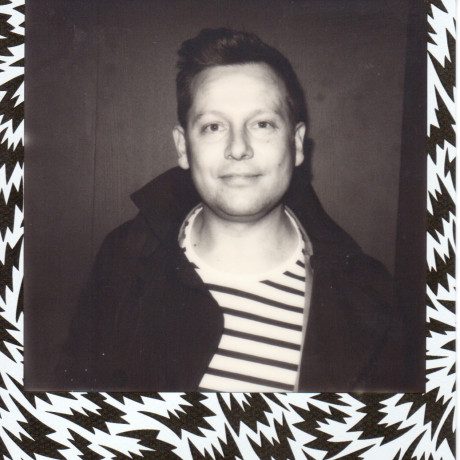Video: Team SkyIris Enters Tesla’s Project Loveday Competition
A few months, ago a young girl called Bria Loveday contacted Elon Musk, asking why Tesla doesn’t produce video advertising. Thus, Project Loveday was born. This competition invited fans to submit a commercial style video 90 seconds in length, promoting the company’s principals and mission. Here’s the story of a small team [SkyIris] producing their short film for the project, overcoming technical difficulties along the way
As a long time Tesla fanboy, Nicholas Raeburn [Nick], from the production company, SkyIris, jumped at the chance to get involved. He knew straight away, that he had to maximise his time to make the best film he could, so decided on a two-day shoot. Nick wanted to make sure we crammed as many technical shots into the story to demonstrate the talent within the SkyIris team as DOP’s and filmmakers.
Logistically they used locations that were close to home, for ease, and as the talent in the film took the shape of Nick’s daughter, he didn’t want to wear her out by travelling miles to far-flung locations.The small crew consisted mainly of friends, who also work in film production.
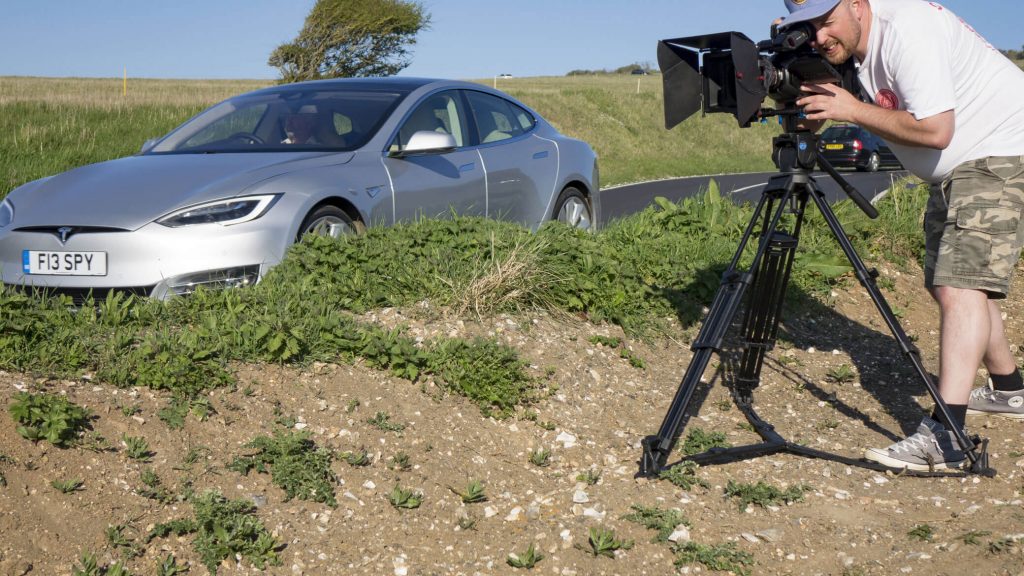
The locations used, were great for natural light and for the wider shots and the team waited for the ‘magic’ hours at both sunrise and sunset for the majority of them. Whilst writing the treatment, Nick listened to a lot of different music to help to mould the story [normal practice for Nick]. One track, in particular, was a track by Peter Sandberg called Dismantle, and whilst writing helped him to see the narrative more clearly, and then knew that this would become the soundtrack for the film.
I wanted to evoke memories of childhood and discovery. I think the Tesla brand reminds us of what it’s like to discover something new and different and the simplicity and innocence of childhood helps cement those feelings – Nick Raeburn DOP/ Director
Once Nick had the story locked down, he produced a shot list. Nick describes himself as a DOP who doesn’t rely too much on storyboards. He said: “As I can see what’s in my head already, for specific shots, sometimes whilst in the middle of shooting you find something in an angle or lighting that you wouldn’t have stumbled on, had you been too prescriptive.”
Moving onto the actual logistics, Nick and his team wanted to make use of the kit they had access to but were also adamant that they wanted a specific look to the film. The Blackmagic Ursa gave them just the look they were after, combined with their Samyang primes gave it a vintage and nostalgic look, which is hard to put into words. This balanced nicely with the futuristic nature of the car.
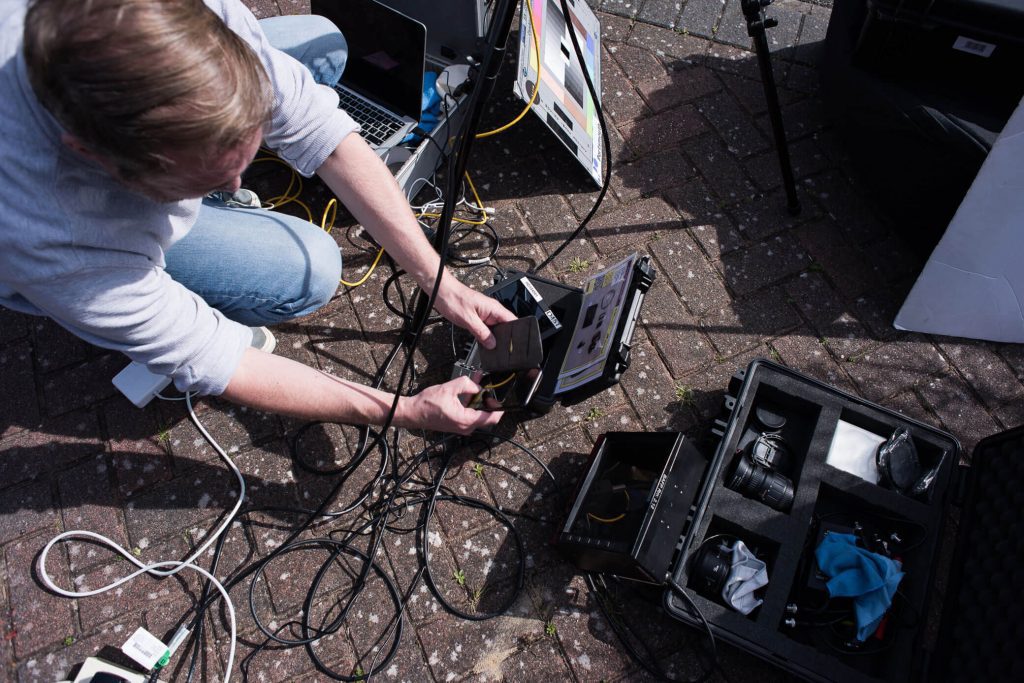
It also helped that they were shooting a lot of scenery under natural light. The rest of the kit used was mainly DJI and the camera from their ‘house’ Inspire when softened slightly proved a good match with the URSA. For workflow, the team opted for a combination of RAW from the Production Camera and Drone, with the 444 2 pro res from the Ursa, to allow for some over cranking with enough colour information. They also recorded pro res proxies to the Blackmagic video assists via SD card for a quick assembly edit which helped whilst shooting on site.
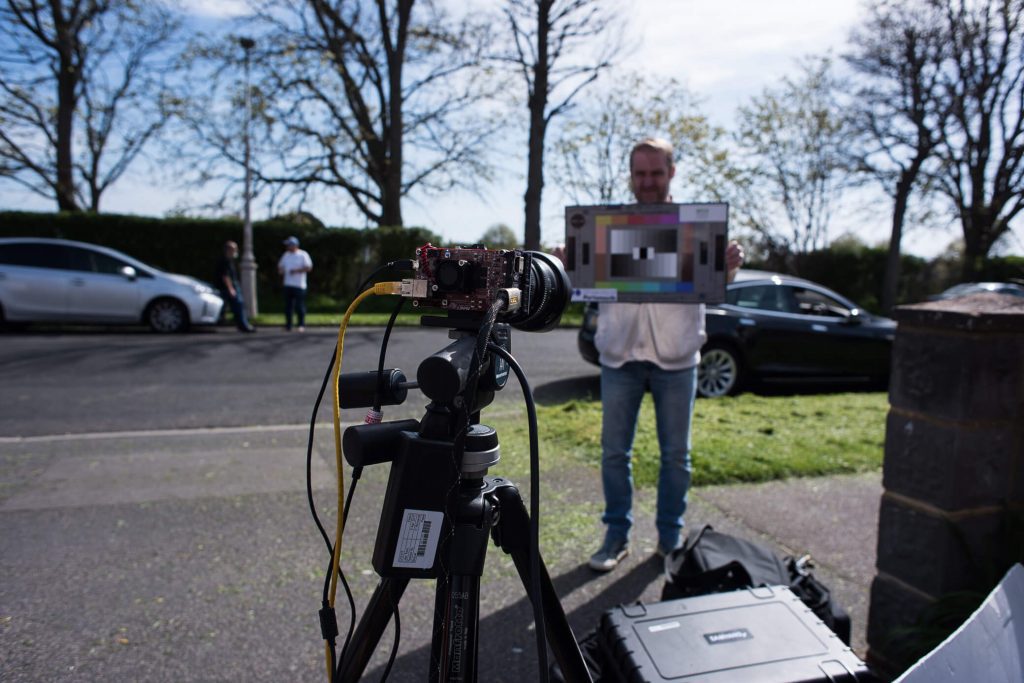
Plans were in motion for drone clips, car-to-car filming, in-car stabilised shooting as well as 3-axis gimbal and close-up work. The progression of new stabilisation and handheld technologies made the majority of the work efficient to execute, but a few shots still posed a real challenge. Harry Turner, from the team, described the logistics of one of the shots and requirement needed: “Nick and myself are seasoned drone pilots and we toyed with the idea of filming everything with the drone, but it would require some tight flying and the lenses available for small platforms weren’t really ideal for what we wanted’.
One of the most dramatic and ambitious shots we were planning was two close up aspects of the car, but also required the car to be moving. – Harry Turner, Rigging Designer
Harry contemplated the idea of hiring in a Russian arm to get the few clips needed, albeit at great cost. Some more research found limitations to most products available, which ruled out hiring one. Nick said: “Often the more affordable rental arms don’t allow you to get the camera close, or in some cases below ground level. This was kind of essential to us. The onset of electric cars made the car-loving world fear a lack of performance, so in this piece, we were purposefully looking to get dynamic shots that looked like the ground was moving quickly. Upon looking at the design of Russian arms and measuring up the boot of his Audi A4 lead car, Harry got to wondering why nobody had built a crane type jib out of the boot of a car? Immediately, after an offer up of some tubing laying around the workshop, we discovered that some really unique angles, the likes of which hadn’t been seen much before, would be possible with this rig. This got us really excited!

The design was pretty simple, a substantial crane design with two roller bearing pivots and a 15ft counterweighted boom. The arms are dampened with two hydraulic rams to absorb shock. The whole design is simply constructed but well balanced to keep the operators happy. It also features a rigging cable to keep the angle of the gimbal mount perpendicular to the running road. The whole unit pivots and the crane is virtually mounted on the car boots edge, you have almost 160 degrees of throw left and right, and almost 60 degrees up. This allows a real variety of angles to be achieved. One feature we’re really proud of, is the ability to go 60 degrees down as well [if that were possible]. It meant that for some shots we could actually drop the whole rig below the height of the road where there was a ditch next to the road. It produced some really interesting revealing shots almost looking up to the car. The crane can hold a variety of weights so a whole array of gimbal systems can be mounted.”
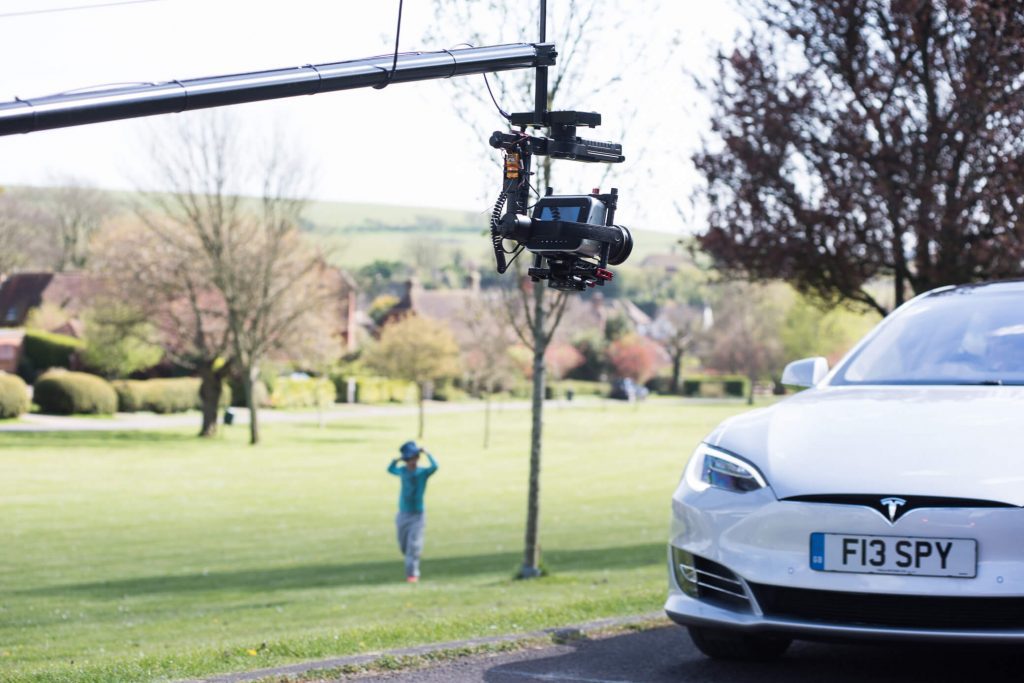
The team used a DJI Ronin-mx for the project, due to its lightweight design but powerful motors. We fed an SDI feedback to the cabin, which was distributed to the crane operator and the gimbal operator. The gimbal operator monitored and recorded a proxy on a Black Magic Video Assist [4K]. They chose to use a Black Magic Cinema Camera filming 2.7k RAW to an SSD and also decided chose a Canon 15-22mm EF-S USM wide angled lens. Traditionally this lens is designed for crop sensor cameras and can produce some nasty soft edges when the lens is fully wide. With this camera though, the micro 4/3’s sensor and the long lens mount from the body actually clip off the nasty areas of the lens, so it films really nicely on this camera.
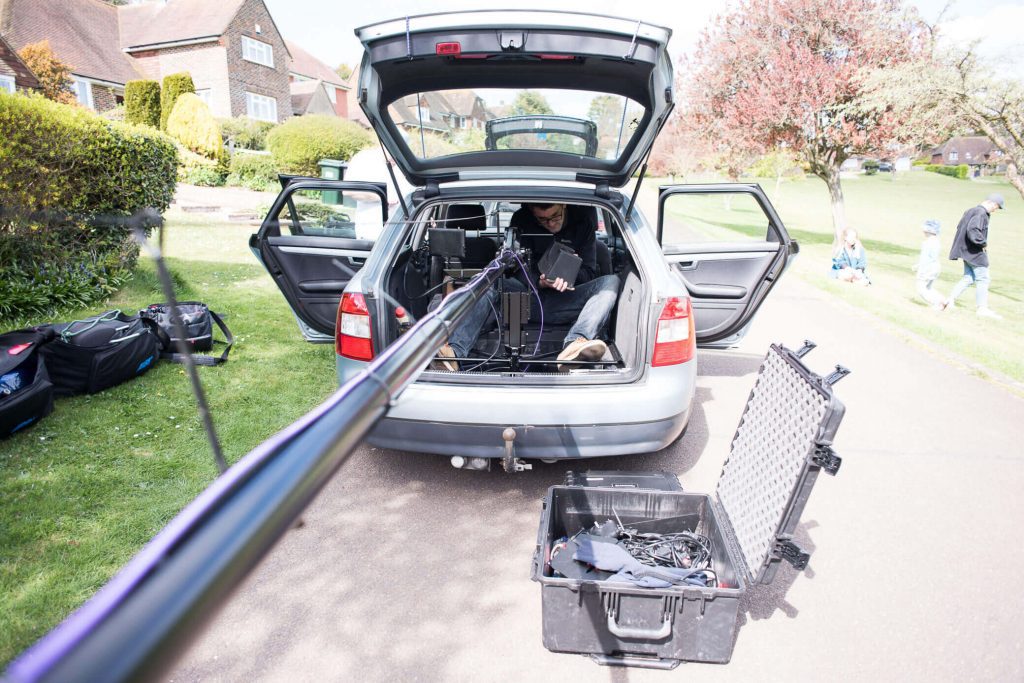
The gimbal was controlled by an Orange SBUS receiver that cleverly converts Spektrum RC signal into SBUS and will allow remote control of the Ronin-mx. The front seat gimbal operator can easily control the powerful DJI Ronin-mx and watch a smooth, high-quality feed. The crane operator got a HDMI feed from the Black Magic Video Assist as a pass through to help co-ordination of shooting. After much consideration, they rated the whole rig to be able to cope up with to around 50mph, although the g-force of sharp corners can be heavy for the operator.
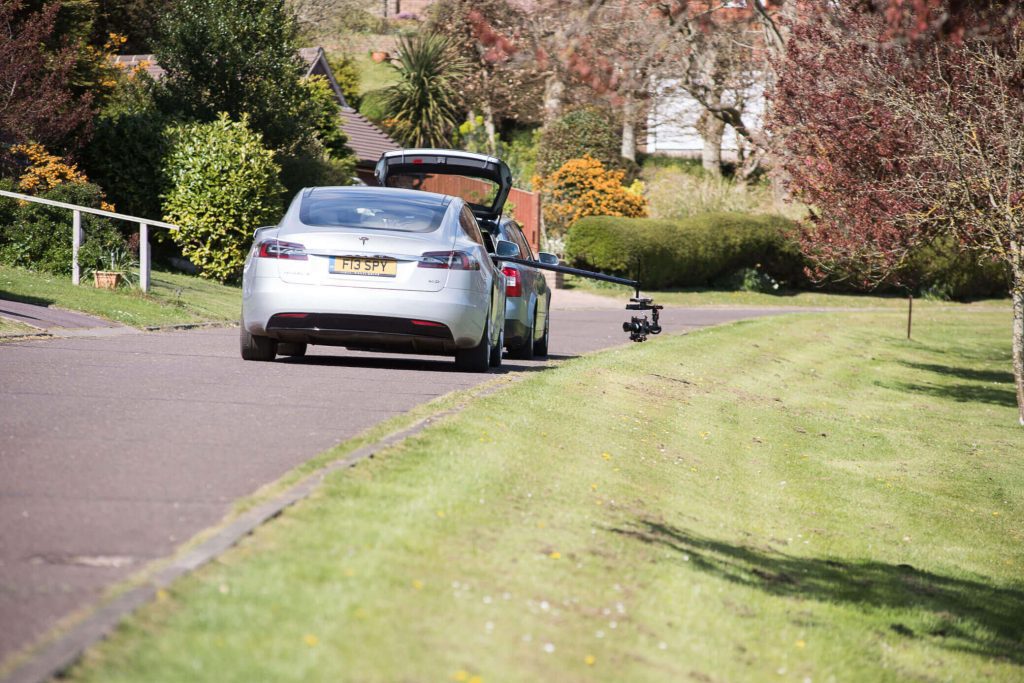
With regards to post-production, Blackmagic’s Da Vinci Resolve gave the team the tools they needed to give the film a warm and natural feel. They assembled an online proxy edit in FCPX [from the video assist pro res proxy files] then once they had the edit locked down, they moved onto Resolve for grading. Once these shots had been graded to their liking, they exported them [whilst both working remotely] and sent them out to Dropbox for re-assembly in the main edit. The team were keen to achieve a tilt-shift effect on the wide aerial shots, to evoke a sense of the world seen through a child’s playset, Resolve allowed them to do this as well as crank up the saturation slightly on the greens in the image to give the film an organic, natural look.
Watch the finished film HERE:

